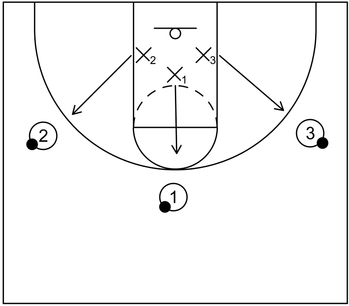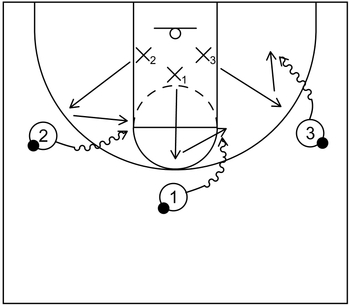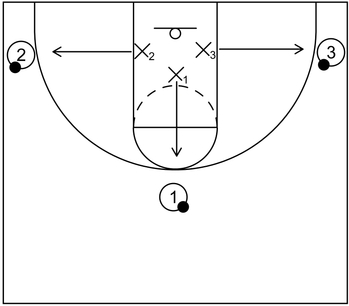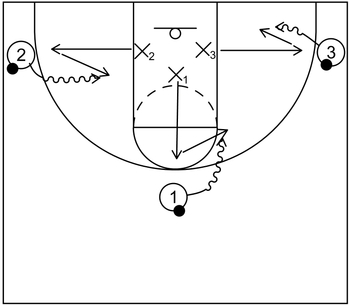What is a closeout in basketball
A closeout is a basketball defensive tactic in which a player on defense will swiftly close the open space on the court between themselves and an adjacent offensive player with the ball, typically to limit or prevent an uncontested jump shot or dribble penetration, particularly towards the basket.
What are the general techniques to execute a closeout
Technique #1
The first technique to execute a closeout is for the defender to have a good defensive stance.
This typically consists of a defender that has their feet about shoulder width apart with their weight on the balls of the feet (not standing flat footed or on their heels).
Also, the defender should have their knees bent, their hips low, their back straight, their chest up, and their eyes looking forward, typically focusing on the ball and/or the offensive player being guarded by the defender.
Related: Basketball Defense: Stance and Slides – YouTube
Technique #2
The second technique to execute a closeout is for the defender to sprint towards the offensive player with the ball, particularly with long steps, while still maintaining a good defensive stance.
This allows the defender to close the space between themselves and the offensive player.
Technique #3
The third technique to execute a closeout is for the defender to use short choppy steps upon completely closing the space between themselves and the offensive player with the ball.
The choppy steps allow the defender to slow down their sprinting speed in an effort to not make unnecessary contact with the offensive player which, in turn, could lead to a needless foul.
Additionally, at the same time, this allows the defender to properly read and react to any potential actions of the offensive player, whether those actions be a jump shot, dribble penetration, or a possible pass to another offensive player.
Technique #4
The fourth technique to execute a closeout is for the defender to get at least one hand up, typically slightly above the shoulders of the offensive player.
The main objective of this particular technique is to limit or prevent an uncontested jump shot or potential pass over the head of the defender such as a post entry pass or a pass to another offensive player cutting to the basket.
Technique #5
The fifth technique to execute a closeout is for the defender to simply not foul the offensive player with the ball on the potential jump shot or possible dribble penetration.
In other words, upon completing the closeout, the defender should not jump into the path of the offensive player during a jump shot attempt. Instead, the defender should utilize choppy steps, as mentioned previously, and jump straight into the air (or perhaps slightly away) to contest a potential jump shot of an offensive player.
Similarly, after executing the closeout, the defender should not reach in too aggressively in an effort to steal the ball from the offensive player. This could lead to a so-called reach-in foul which is not desirable for the defensive player or the defensive team in general.
Also, if the offensive player with the ball attempts to execute dribble penetration, then the closeout defender should not extend one or both of their hands or arms beyond the legal space (which is typically the defender’s own personal space) in an effort to control the offensive player.
This will most likely lead to an unnecessary foul for the defender that executed the closeout.
Related: Handcheck Rules – NBA Video Playbook
What are examples of simple closeout drills
Drill 1

This is an example of a closeout drill in which the defenders will close the space between themselves and the offensive players at the top and wing areas of the court.
To start, X1, X2, and X3 execute closeouts toward 1, 2, and 3 near the top, left side wing, and right side wing, respectively.
After completing the drill, the offensive players could switch to defense while the defensive players could switch to offense.
Drill 2

This is an example of a closeout drill in which the the defenders will close the space between the offensive players at the top and wing areas of the court, similar to the previous example.
However, this time, the three offensive players will execute dribble penetration towards the basket as well.
To start, X1, X2, and X3 execute closeouts toward 1, 2, and 3. When that occurs, 1, 2, and 3 execute dribble penetration with the right hand towards the basket.
From that point, X1, X2, and X3 should move their feet laterally to limit or prevent the dribble penetration. After completing the drill, the offensive and defensive players could switch sides.
Drill 3

This is another example of a closeout drill in which the defenders will close the open space between themselves and the offensive players at the top and corner areas of the court.
To begin, X1, X2, and X3 execute closeouts toward 1, 2, and 3 near the top, left side corner, and right side corner, respectively.
After completing the drill, the offensive players could switch to defense while the defensive players could switch to offense.
Drill 4

This is another example of a closeout drill that is similar to the previous example. However, this time, the three offensive players will execute dribble penetration towards the basket.
To begin, X1, X2, and X3 execute closeouts toward 1, 2, and 3. When that occurs, 1, 2, and 3 execute dribble penetration with the right hand towards the basket.
From that point, X1, X2, and X3 should move their feet laterally to limit or prevent the dribble penetration. After completing the drill, the offensive and defensive players could switch sides.